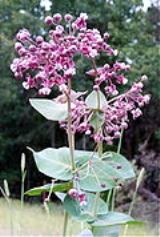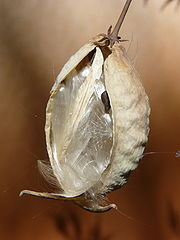
Asclepias cordifolia
Encyclopedia
Asclepias cordifolia is a species of milkweed commonly called Heart-leaf milkweed or Purple milkweed (a common name shared with another milkweed, Asclepias purpurascens
). It is native to the western United States
(California, Nevada, Oregon), growing between 50 to 2000 m (164 to 6,561.7 ft) elevation in the northern Sierra Nevada and Cascade
ranges. Heart-leaf milkweed was valued by the Native American Miwok
tribe for its stems, which they dried and processed into string and rope.
 Heart-leaf milkweed is a perennial that grows to a height of 0.3 to 0.6 m (0.984251968503937 to 2 ft), with dark red-purple flowers whose hoods are slightly elevated above the base of the corolla. The flower structure is unusual—it has five stamen
Heart-leaf milkweed is a perennial that grows to a height of 0.3 to 0.6 m (0.984251968503937 to 2 ft), with dark red-purple flowers whose hoods are slightly elevated above the base of the corolla. The flower structure is unusual—it has five stamen
s fused into a column, with five circular attachments called 'hoods', and an anther head surrounding the large stigma at the flower's center. The fruit (photo at left) is a follicle
with many flat seeds that have silky hairs which disperse easily in the wind. The large opposite leaves are cordate, or heart-shaped. The plant grows in open or shaded woodland, often on rocky slopes and in mixed coniferous forest. The milkweeds are named for the milky sap which exudes from the plant's stem.
for 'heart-leaved'), refers to the heart-shaped leaves, while the genus name honors the Greek physician Asclepius
.
caterpillars are commonly found on all the milkweeds, including the Heart-leaf milkweed. Even after the caterpillar has metamorphosed into a butterfly, the alkaloid
s they ingest from the plant are retained in the butterfly, making it unpalatable to predators.
gathered Heart-leaf milkweed in the summer and dried it, or collected it in the fall after it was already dry. The dry stems were combed with a loop of willow
to draw out the fiber just beneath the very thin outer skin. The fiber was wound into balls for storage and later processing. The making of cordage (rope and string) was done entirely by hand, with no tools. Asclepias was also used by the Native American Yokut or Mariposa in northern and central California for string or rope.
A single Miwok feather skirt or cape was made with approximately 100 feet of cordage, requiring about 500 plant stalks. A 40-foot-long deer net contained about 7,000 feet of cordage, requiring the harvesting of approximately 35,000 plant stalks. The milkweed stalks were burned in the fall to eliminate dead stalks and stimulate the next year's growth, and to stimulate flower and seed production. Cordage was typically two-ply, though there are some examples at the Field Museum of three- and four-ply Miwok cordage.
Heart-leaf milkweed was also used as a contraceptive and snakebite remedy, though without proper preparation it can cause vomiting in low doses and death in higher doses due to a mix of cardenolide
s in the sap. At one time it was classified as a noxious weed because of reported negative effects on livestock.
Asclepias purpurascens
Purple milkweed is a herbaceous plant species. It is in the genus Asclepias, making it a type of milkweed. It is native to the Eastern, Southern and Midwestern United States similar to the range of the Common Milkweed...
). It is native to the western United States
United States
The United States of America is a federal constitutional republic comprising fifty states and a federal district...
(California, Nevada, Oregon), growing between 50 to 2000 m (164 to 6,561.7 ft) elevation in the northern Sierra Nevada and Cascade
Cascade Range
The Cascade Range is a major mountain range of western North America, extending from southern British Columbia through Washington and Oregon to Northern California. It includes both non-volcanic mountains, such as the North Cascades, and the notable volcanoes known as the High Cascades...
ranges. Heart-leaf milkweed was valued by the Native American Miwok
Miwok
Miwok can refer to any one of four linguistically related groups of Native Americans, native to Northern California, who spoke one of the Miwokan languages in the Utian family...
tribe for its stems, which they dried and processed into string and rope.
Description

Stamen
The stamen is the pollen producing reproductive organ of a flower...
s fused into a column, with five circular attachments called 'hoods', and an anther head surrounding the large stigma at the flower's center. The fruit (photo at left) is a follicle
Follicle (fruit)
In botany, a follicle is a dry unilocular many-seeded fruit formed from one carpel and dehiscing by the ventral suture in order to release seeds, such as in larkspur, magnolia, banksia, peony and milkweed....
with many flat seeds that have silky hairs which disperse easily in the wind. The large opposite leaves are cordate, or heart-shaped. The plant grows in open or shaded woodland, often on rocky slopes and in mixed coniferous forest. The milkweeds are named for the milky sap which exudes from the plant's stem.
Taxonomy
The species name, cordifolia (LatinLatin
Latin is an Italic language originally spoken in Latium and Ancient Rome. It, along with most European languages, is a descendant of the ancient Proto-Indo-European language. Although it is considered a dead language, a number of scholars and members of the Christian clergy speak it fluently, and...
for 'heart-leaved'), refers to the heart-shaped leaves, while the genus name honors the Greek physician Asclepius
Asclepius
Asclepius is the God of Medicine and Healing in ancient Greek religion. Asclepius represents the healing aspect of the medical arts; his daughters are Hygieia , Iaso , Aceso , Aglæa/Ægle , and Panacea...
.
Monarch butterfly
Monarch butterflyMonarch butterfly
The Monarch butterfly is a milkweed butterfly , in the family Nymphalidae. It is perhaps the best known of all North American butterflies. Since the 19th century, it has been found in New Zealand, and in Australia since 1871 where it is called the Wanderer...
caterpillars are commonly found on all the milkweeds, including the Heart-leaf milkweed. Even after the caterpillar has metamorphosed into a butterfly, the alkaloid
Alkaloid
Alkaloids are a group of naturally occurring chemical compounds that contain mostly basic nitrogen atoms. This group also includes some related compounds with neutral and even weakly acidic properties. Also some synthetic compounds of similar structure are attributed to alkaloids...
s they ingest from the plant are retained in the butterfly, making it unpalatable to predators.
Uses
The MiwokMiwok
Miwok can refer to any one of four linguistically related groups of Native Americans, native to Northern California, who spoke one of the Miwokan languages in the Utian family...
gathered Heart-leaf milkweed in the summer and dried it, or collected it in the fall after it was already dry. The dry stems were combed with a loop of willow
Willow
Willows, sallows, and osiers form the genus Salix, around 400 species of deciduous trees and shrubs, found primarily on moist soils in cold and temperate regions of the Northern Hemisphere...
to draw out the fiber just beneath the very thin outer skin. The fiber was wound into balls for storage and later processing. The making of cordage (rope and string) was done entirely by hand, with no tools. Asclepias was also used by the Native American Yokut or Mariposa in northern and central California for string or rope.
A single Miwok feather skirt or cape was made with approximately 100 feet of cordage, requiring about 500 plant stalks. A 40-foot-long deer net contained about 7,000 feet of cordage, requiring the harvesting of approximately 35,000 plant stalks. The milkweed stalks were burned in the fall to eliminate dead stalks and stimulate the next year's growth, and to stimulate flower and seed production. Cordage was typically two-ply, though there are some examples at the Field Museum of three- and four-ply Miwok cordage.
Heart-leaf milkweed was also used as a contraceptive and snakebite remedy, though without proper preparation it can cause vomiting in low doses and death in higher doses due to a mix of cardenolide
Cardenolide
Cardenolide is a type of steroid. Many plants contain derivatives, collectively known as cardenolides, including many in the form of cardenolide glycosides...
s in the sap. At one time it was classified as a noxious weed because of reported negative effects on livestock.

